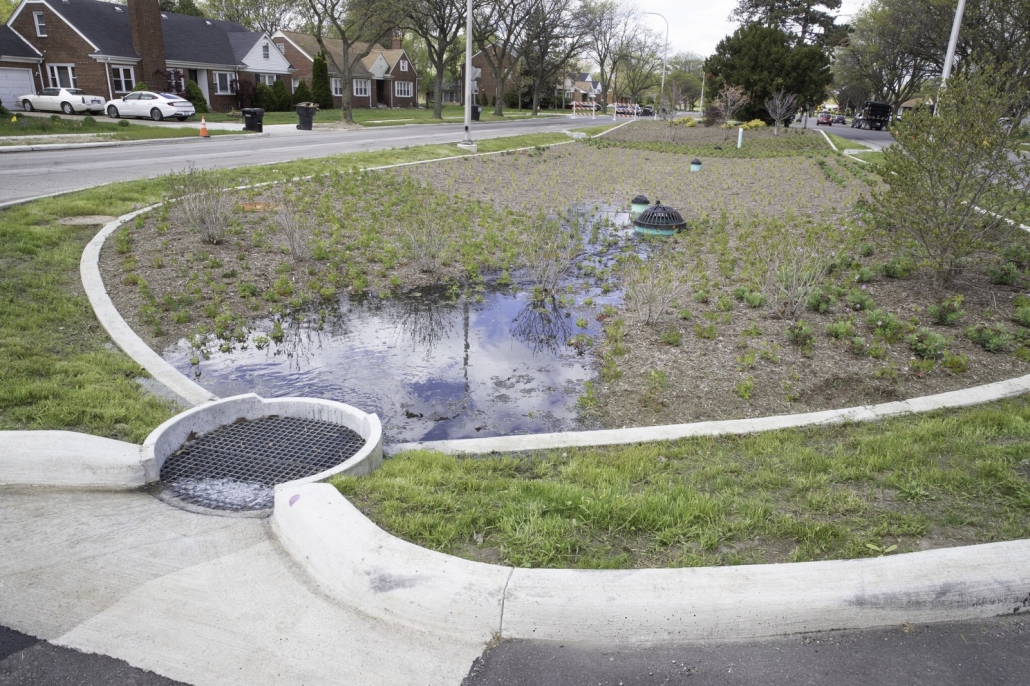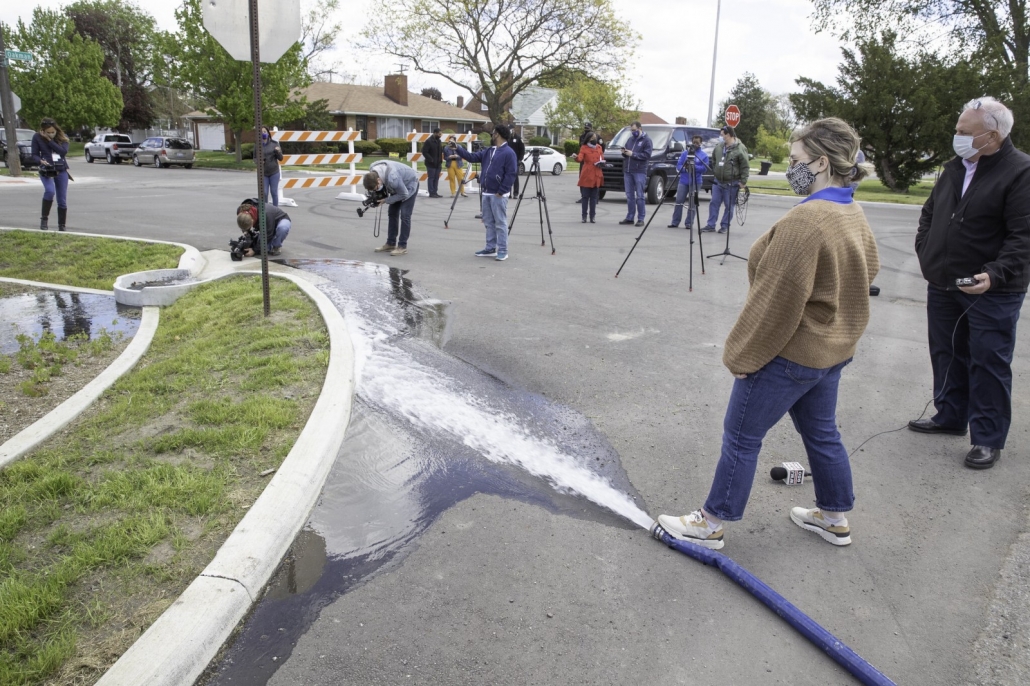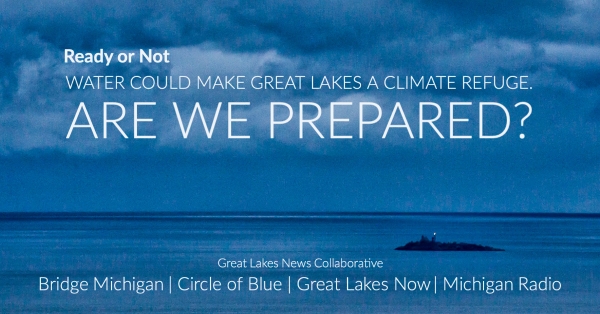
Water soaks into the soil of a bioretention feature on Oakman Boulevard in Detroit during a demonstration, May 11, 2021. Courtesy: City of Detroit
By Andrew Blok, Great Lakes Now, – May 18, 2021
Water ran from a fire hydrant, down the street and into a recently redesigned street median in Detroit last week.
It was both unassuming and a demonstration of the city’s single largest investment in green stormwater infrastructure: infrastructure that uses natural processes like the ability of soil and plants to filter and store water. The 10 reworked street medians on Oakman Boulevard will help manage 37.3 million gallons of stormwater a year, easing the burden on the city’s wastewater system and reduce basement flooding.
In August 2014, historic and deadly flooding took Detroit by surprise. Heavy rains submerged interstate highways, swamped vehicles, filled basements and caused an estimated billion dollars in damage.
The city responded, in part, by turning to green stormwater infrastructure.
It’s a strategy that cities around the Great Lakes basin have increasingly been employing to ease the burden on their wastewater infrastructure and improve water quality, while deferring or avoiding costly upgrades to wastewater treatment plants.
It’s also a valuable adaptation to a changing climate, which is likely to make rainstorms more severe.
Reducing street flooding by catching millions
Street flooding occurs when too much rain falls too quickly, and stormwater systems can’t keep up. Water can also back up through drains into nearby basements.
After the 2014 floods, Detroit officials started meeting with residents of one flooded neighborhood to discuss possible solutions to their flooding problem, said Bryan Peckinpaugh, the deputy director of public affairs for the Detroit Water and Sewage Department.
After years of discussion and planning, the city turned the medians on Oakman Boulevard into bioretention features. These features look like large rain gardens and allow stormwater from the street to flow into the median where it filters through the ground and some of it is collected in large tanks below the surface. Those tanks slowly release stormwater back to the sewer system, easing the load on the whole system.
Storm drains in nearby areas were diverted to the new bioretention areas as well, bumping the affected area to 400 acres, Peckinpaugh said.
The bioretention features will help manage 37.3 million gallons of water each year, according to a press release about the project from the Detroit Water and Sewage Department.
Residents are noticing a difference.
Earlier this year Mackenzie Street, locally referred to as Lake Mackenzie, was uncharacteristically free of standing water during the first big rain since the project’s completion, Peckinpaugh said.

City officials demonstrate the Oakman Boulevard bioretention features ability to absorb stormwater. Courtesy: City of Detroit
Fewer floods, better water quality
Green stormwater infrastructure does far more than reduce flooding.
It protects water bodies that receive stormwater by filtering out pollutants from impermeable surfaces like parking lots, streets or roofs. As water filters through soil, it leaves some of those pollutants behind. When it finally reaches the receiving waters, it’s cleaner.
By slowing the flow of stormwater to the sewers, green stormwater infrastructure can also reduce combined sewer overflows, which occur when heavy storms overwhelm the wastewater system and stormwater and sewage is discharged directly into a river or lake.
In 2019, the most recent report data available, 2.7 billion gallons of untreated sewage and stormwater spilled into Michigan’s waterways in combined sewer overflows.
“The gold standard of green stormwater infrastructure is that our receiving waters—our lakes, our streams and our rivers—they don’t know that we developed the landscape around it,” said Donald Carpenter, professor of practice of civil and architectural engineering at Lawrence Technological University in Southfield, Michigan.
In terms of achieving that goal, “we’re not even close,” Carpenter said.
In the Great Lakes basin, green infrastructure like that in Detroit might have an outsized impact because it protects the largest store of surface freshwater in the world. Projects around the basin are planned or in place that could have a major impact on water quality.
The increase of green infrastructure is largely due to the Clean Water Act, a 1972 law that set standards for water quality, said Joan Nassauer, a professor at the School of Environment and Sustainability at University of Michigan.
By 2035, the Milwaukee Metropolitan Sewerage District plans to use green infrastructure to capture the first half inch of rain that falls in its service area, about 740 million gallons of water.
The Northeast Ohio Regional Sewer District has reduced stormwater runoff in the Cleveland area by more than 26 million gallons a year through grants for green stormwater infrastructure projects.
Cities are also required by the U.S. EPA to implement green infrastructure.
In 2014, Chicago was required to use it to reduce street flooding and basement backups, including transitioning vacant lots into stormwater parks that both filter water and provide recreation opportunities to the public.
Cleveland was required in 2010 to spend $42 million on green infrastructure.
And in southern Indiana on the Ohio River, a park is being designed, not to mitigate flooding, but to adapt to it.
When the river floods, Origin Park, in Clarksville and New Albany, Indiana, won’t shut down. It’ll just be used differently.
“A lot of our woods will flood seasonally. So what that means is in July and August, you’ll be hiking through the woods, but then in March and April, you’ll be paddling through those same woods,” said Scott Martin, the executive director of River Heritage Conservancy, the organization building and running the park.
The park is “100% climate change oriented,” Martin said.
Current conditions don’t require elevated trails or building canoe put-ins so far from the river that people will think they’re “insane.” For Origin Park, it’s all about looking ahead and building for what’s coming.
“This is the frontline of climate change,” Martin said. “If we’re really intentional and thoughtful about it, we can design cities that are even more livable, more green, in places where people don’t expect to see it.”
The park’s first construction is getting underway. A canoe path will open by the end of the year.
Planning for a changing future
Replacing or supplementing grey infrastructure—storm drains, pipes, treatment facilities—with green can save cities time and money.
“To rip out and replace all this grey infrastructure would cost billions if not trillions of dollars,” Carpenter said. But adding green infrastructure can lighten the burden put on stormwater infrastructure by changing precipitation patterns.
Climate change is expected to increase Great Lakes rainfall by 10 to 20%, according to the National Oceanic and Atmospheric Administration. That’s due in part to an increase of heavy rainstorms that can overwhelm stormwater and sewer systems built to rainfall expectations of past decades.
That’s just one area that green infrastructure can help.
“Green stormwater infrastructure has all these other ancillary benefits that make it really attractive,” Carpenter said.
Common green stormwater infrastructure tools—rain gardens, bioretention features or growing plants on roofs—incorporate plants, which also improve air quality, make for cooler neighborhoods and act as public health-boosting greenspace, Carpenter said.
Nassauer, who has installed large bioretention projects in Detroit, says vacant land in large Great Lakes cities with shrinking populations are perfect for green infrastructure projects.
Changing vacant lots into park-like rain gardens can transform a neighborhood. Gardens she helped install six or seven years ago regularly come up in conversations with locals, who appreciate the benefits beyond flooding, she said.
Ready or not — the Great Lakes as a climate refuge
The Great Lakes region is frequently touted as one of the most climate-resilient places in the U.S., in no small part because of its enviable water resources. But climate change threatens water quality, availability, and aging water infrastructure by exposing existing vulnerabilities and creating new ones. In this series, members of the Great Lakes News Collaborative explore what it may take to prepare the Great Lakes region for the future climatologists say we can expect.
Funded by the Charles Stewart Mott Foundation, the collaborative’s four nonprofit newsrooms — Bridge Michigan, Circle of Blue, Great Lakes Now at DPTV and Michigan Radio — aim to elevate discussion, amplify the voice of Michigan residents and produce action that protects the region’s waters for future generations. While Mott provides financial support, our public service journalism is produced independently.



